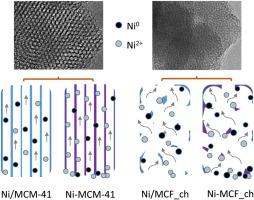Journal of CO2 Utilization ( IF 7.2 ) Pub Date : 2020-10-23 , DOI: 10.1016/j.jcou.2020.101328 M. Aneley Paviotti , Luis A. Salazar Hoyos , Valentina Busilacchio , Betina M. Faroldi , Laura M. Cornaglia

|
In this work, rice husk ashes were used to obtain a high purity silica precursor to synthesize mesoporous silica frameworks. A novel route for the synthesis of mesocellular silica foam (MCF) was developed using microwave irradiation during the hydrothermal treatment. Cyclohexane and cetyltrimethylammonium bromide were employed as swelling and structure-directing agents, respectively. Ni-based catalysts supported on MCM-41 and MCF mesostructured materials were obtained using two methods, one-pot and incipient wetness impregnation. The catalysts prepared for both methods presented noticeable differences in the metal-support interaction, which were observed by TEM, SAXRD, TPR and XPS. The impregnated catalysts showed preferentially Ni particles inside the pore structure of the support while the one-pot catalysts also showed Ni particles within the silica framework. The catalysts were evaluated in the CO2 methanation reaction between 200 and 500 °C at atmospheric pressure. The samples prepared by impregnation showed better catalytic performance than those prepared by the one-pot method. Thereby, the Ni particles highly distributed within the pore improved the CO2 methanation reaction. The Ni/MCF_ch_iwi presented the best catalytic performance reaching CO2 conversions and CH4 selectivities close to the reaction equilibrium, from 350 to 500 °C. The Ni/MCF_ch_iwi also showed high structure and catalytic stability, as well as coke resistance formation under reaction conditions.
中文翻译:

稻壳骨灰微波辅助合成CO 2甲烷化制Ni介孔催化剂
在这项工作中,稻壳灰被用来获得高纯度的二氧化硅前体,以合成介孔二氧化硅骨架。在水热处理过程中,利用微波辐照开发了一种合成介孔二氧化硅泡沫(MCF)的新途径。环己烷和十六烷基三甲基溴化铵分别用作溶胀剂和结构导向剂。使用一锅法和初期湿法浸渍两种方法获得了负载在MCM-41和MCF介孔结构材料上的Ni基催化剂。两种方法制得的催化剂在金属-载体相互作用中均表现出显着差异,通过TEM,SAXRD,TPR和XPS观察到。浸渍的催化剂优选在载体的孔结构内显示Ni颗粒,而一锅法催化剂也显示在二氧化硅骨架内的Ni颗粒。在CO中评估了催化剂在大气压下于200至500°C之间进行2次甲烷化反应。通过浸渍制备的样品显示出比通过一锅法制备的样品更好的催化性能。从而,高度分布在孔内的Ni颗粒改善了CO 2甲烷化反应。在Ni / MCF_ch_部落呈现最好的催化性能达到CO 2的转化率和CH 4的选择性接近反应平衡,从350至500℃。在Ni / MCF_ch_部落还表明在反应条件下高的结构和催化稳定性,以及焦炭电阻形成。









































 京公网安备 11010802027423号
京公网安备 11010802027423号